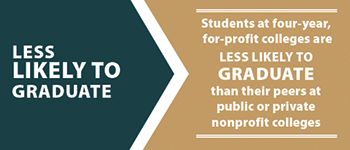Students at Colorado’s for-profit colleges have less favorable outcomes in comparison to their peers at public and private non-profit institutions according to several key indicators, and the impact is greater on students of color. This report uses the data released from the US Department of Education (College Scorecard, September 2015) and compares public, private, and for-profit institutions (also referred to as “colleges” or “schools”) on the basis of overall enrollment, average demographic makeup, completion rates, and indications of student financial burden post-graduation. Analyzing this data, the Center for Responsible Lending finds the following:
- Lower graduation rates. Students at Colorado’s for-profit 4-year colleges are less likely to graduate than their peers at public or private non-profit colleges. Completion rates averaged only 26% for 4-year for-profit schools compared to 44% and 53% respectively for public and private 4-year schools.
- Higher debt burdens. For those who do graduate, for-profit students leave school with substantially higher federal debt than their public and private peers ($32,452 compared to $21,345 and $24,726 respectively).
- Higher default rates. Poor completion rates and high debt levels for those few students who do complete result in discouraging figures for post-separation federal loan repayment at for-profit institutions. Three years after separation, Colorado’s 4-year for-profit institutions report an average cohort default rate of 14.7% — more than double the comparable figures of 7.3% and 5.0% respectively for public and private peers. For those student in for-profit institutions who have not defaulted, many have made no progress on repayment, with only 52% having repaid any amount compared to 67% and 66% respectively for public and private peer institutions.
- Disproportionate impact on students of color. Enrollment at Colorado’s for-profit institutions is disproportionately African-American (11%) and low-income (57%) relative to public and private institutions (5% and 7% African American and 35% and 43% low-income respectively). For-profit enrollment is particularly striking when one considers that it represents 44% of all African American students enrolled in Colorado institutions, but only 16% of the overall undergraduate population.
